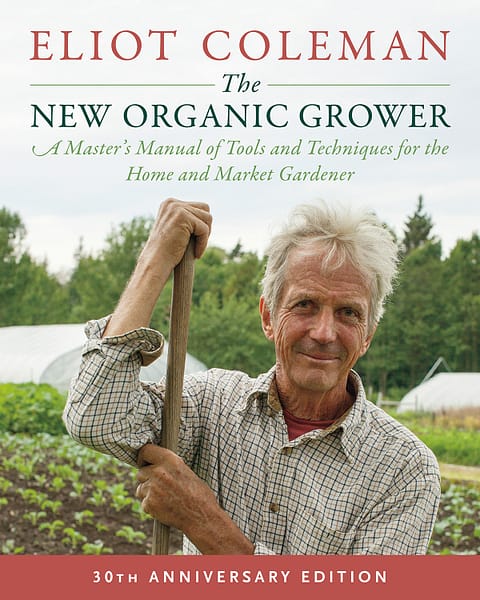Building Your Own Root Cellar for the Fall Harvest

Building a root cellar is a great way to keep your harvest fresh through the cold months. With protection from weather and animals, these cellars can be just as good as a regular refrigerator. They can be built into a wall in your basement, dug into the ground, or simply buried.
The following excerpt is from Four-Season Harvest by Eliot Coleman. It has been adapted for the web.
How to Build A Root Cellar For Fall
No one wants second best. A slimy cabbage from a dingy corner of the basement will never compete with the crisp specimens on the vegetable shelf of the supermarket. Wilted, dried-out carrots look unappealing next to the crunchy, plastic-wrapped beauties in the refrigerator. When home storage is unsuccessful, a case can be made for artificial refrigeration.
But the cabbage need not be slimy nor the carrots wilted. A properly constructed root cellar does not take a backseat to any other method of food storage. It is no great feat to manage a simple underground root cellar so that the produce will be equal or superior in quality to anything stored in an artificially refrigerated unit, even after long periods of storage.
What Makes For A Successful Root Cellar?
A successful root cellar should be properly located, structurally sound, weather tight, convenient to fill and empty, easy to check on and clean, and secure against rodents.
Proper location means underground at a sufficient depth so frost won’t penetrate. The cellar should be structurally sound so it won’t collapse on you. It needs to be weather tight so cold winds can’t blow in and freeze the produce.
You need to have easy access to fill it, to use the produce, and to clean it at the end of the winter. And it should be rodent-proof so all the food you have stored away won’t be nibbled by rats and mice.
Provision must be made for drainage as with any other cellar, and the cellar should be insulated so that it can maintain a low temperature for as long as possible and provide properly humid storage conditions.
Finally, microclimates within the cellar (colder near the floor, warmer near the ceiling) should allow you to meet different temperature and moisture requirements for different crops. The cellar will be most successful if it incorporates your underground food storage needs into one efficient, compact unit. It’s surprising how easily a hole in the ground meets all those conditions.
Perfect Spot for a Root Cellar: Your Basement
Any house with a basement already has a potential root cellar. You just need to open a vent so cold air can flow in on fall nights, and sprinkle water on the floor for moisture. The temperature control in the root cellar is almost automatic because cold air, which is heavier than warm air, will flow down, displacing the warmer air, which rises and exits. This lowers the temperature in the cellar incrementally as fall progresses and the nights get cooler.
By the time outdoor conditions are cold enough to require moving root crops to the cellar (around October 21 to November 7 here in Maine), conditions in the underground garden are just right-cool and moist. With minimal attention, they will stay that way until late the next spring.
Material Considerations
No wood or other material that might suffer from being wet should be used in root cellar construction. The ideal root cellar is made of concrete or stone with rigid insulation around the outside. Any permanent wood in a root cellar soon becomes damp and moldy.
Wood will not only rot but also will serve as a home for bacteria and spoilage organisms and is subject to the gnawing entry of rodents. The stone or concrete cellar is impregnable. It won’t rot or decompose, and the thick walls hold the cool of the earth.
Build a Wall or Dig a Pit
The easiest way to make a root cellar is to wall off one corner of the basement as a separate room. The best material is concrete block. There is no problem even if the rest of the basement is heated. You simply need to insulate one temperature zone from the other.
Leave enough space between the top of the walls and the joists of the floor above so you can install a cement-board ceiling with rigid insulation above it. Also attach rigid insulation to the heated side of the cellar walls you build. The insulation can be protected with a concrete-like covering such as Block Bond. Install an insulated metal door for access, and the structure is complete.
There are several simpler options, especially for storing small quantities of vegetables.
Storing Vegetables in Your Root Cellar
If your house has an old-fashioned cellar with a dirt floor and there is enough drainage below floor level, you can dig a pit in the floor 18 to 24 inches deep, line it with concrete blocks, and add an insulated cover. You will want to open the cover every few days to encourage air exchange in the pit.
The pit won’t be as easy to use as a room you can walk into, but like any hole in the ground, it should keep root crops cool and moist. In warmer climates, you can use similar pits or buried barrels for storage either outdoors or in an unheated shed.
Tried-And-True Storage Techniques
One of the simplest techniques we ever used, before we had a root cellar, was to dig pits in one section of the winter greenhouse. In that case we used metal garbage cans and buried them to their edge in the soil under the inner layer. To make sure they stayed cool we insulated their lids. We filled those cans with all the traditional root crops after their late fall harvest.
Our whole winter food supply that year was in one central spot and when we went out to harvest fresh spinach and scallions for dinner we would bring back stored potatoes and cabbage at the same time.
Recommended Reads
Recent Articles
Have you heard of silvopasture? This system of managing grazing animals is an ancient practice that integrates trees and pasture into a single system for raising livestock. These systems are managed for both forest products and forage, providing short-and long-term income sources in a mutually beneficial way for healthier animals, better soil, less pest control and mowing, and…
Read MoreNothing says “spring” like a fresh, foraged meal! Savor the flavors of the season with this Milkweed Bud Pizza recipe.
Read MoreOxeye daisies are one of the most important plants for pollinators including beetles, ants, and moths that use oxeye daisies as a source of pollen and nectar. Instead of thinking about removing a plant like oxeye daisy, consider how you can improve the fertility and diversity of habitat resources in your home landscape, garden, or…
Read MoreSo you want to start reaping your harvest, but you’re not sure where to start? Learn how to break down the options of harvesting tools!
Read More











